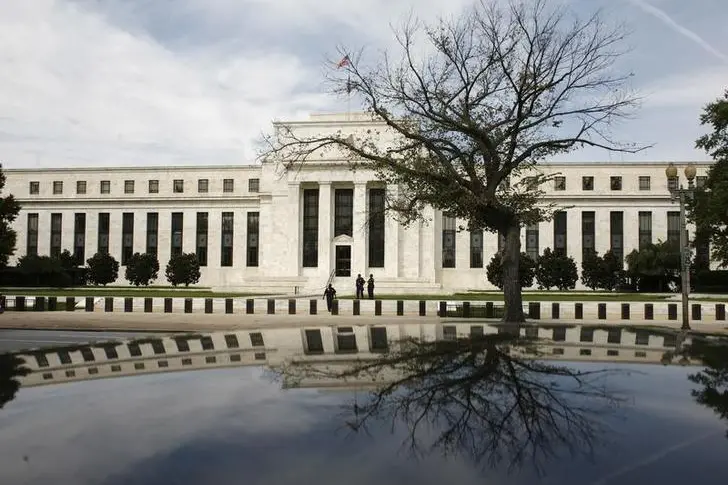PHOTO
NEW YORK - A surge in hedging to protect against aggressive Federal Reserve tightening has caused liquidity problems in the interest rate options sector, reflecting a trend that has been going on in some parts of the bond market.
Strong demand has hoisted volatility on so-called swaptions, or options on interest rate swaps, which give the buyer the right to enter into a contract in the future at a pre-determined price. Swaptions are one segment of the roughly $490 trillion over-the-counter interest rate derivatives market.
Volatility or "vol" is a key measure of how much risk is perceived, and is a major input in the price of an option. Demand for options for hedging or speculation tends to lift vol and the higher the vol, the greater the perceived uncertainty over a given time frame.
In rate markets, swaps, a gauge of the cost of exchanging fixed-rate cash flows for floating-rate ones over a specific period, are often used by investors to bet on where Fed policy rates are headed.
The surge in hedging in the swaptions market has come from fixed-income investors and equity portfolio managers who would normally not hedge using rate options, market participants said. They have been doing so in the last few months since the Fed shifted its stance on inflation and telegraphed that it would soon start tightening, which it did for the first time in 3-1/2 years last month.
Analysts said the appetite for rate options increased further after Fed Chair Jerome Powell told the National Association for Business Economics on March 21 that the Fed must move "expeditiously" to raise rates and possibly "more aggressively" to keep an upward price spiral from getting entrenched.
"Equity managers understood very well the risks of a tighter Fed and tighter financial conditions to portfolios and found a decent hedge in the rates vol space," said Bruno Braizinha, director, U.S. rates strategy, at BoFA Securities in New York.
"Not only did equity guys buy vol, they bought directional vol. That created a bit of a one-way market - you have rates clients buying that vol and you have equity clients buying that vol as well," he added, which he said caused liquidity issues.
Liquidity has also been an issue in the U.S. Treasuries market, with the spike in yields.
In an illiquid market, the bid-offer spreads on options widen because dealers need to take into account the difficulty in hedging a position.
Traders said investors bought "payer swaptions" involving U.S. one-year and two-year swap rates, with expiries from anywhere between six months to two years.
Payer swaptions give the buyer the right to enter into an interest rate swap where the buyer pays fixed rate and receives a floating rate. The buyer therefore benefits if rates rise.
Normalized volatility on shorter-dated swaptions such as one-year at-the-money options on one-year swap rates, that part of the curve in which Fed policy is being priced, soared to 145 basis points on Tuesday, from 110 basis points at the start of March.
In late March, normalized vol hit 152 basis points, the highest since at least February 2013, according to Refinitiv data. Since Powell's hawkish speech on March 21, vol on one-year swap rates surged about 17 basis points.
"Liquidity tends to be poor when volatility is high," said Amrut Nashikkar, managing director and senior rates strategist at Barclays in New York. "But then, there's also some contribution the other way, where illiquid markets cause volatility."
VOLATILITY SURROUNDING FED'S TERMINAL RATE
That volatility reflects how investors view uncertainty around the Fed's terminal rate, or the peak of the U.S. central bank's rate-hike cycle.
The U.S swaps forward market sees the terminal rate hitting between April 2023 and April 2024 at roughly 3%, based on the one-year and two-year forwards of one-year swap rates, analysts said. .
The 145 basis-point volatility on one-year at-the-money options suggested that the terminal rate could hit 3% sometime in the fourth quarter of 2023, but that rate could land at either 1.5% or 4.5%.
"That's a huge gap to navigate and lot of uncertainty as to where the Fed is going to land over the next year," said BoFA's Braizinha, which he said therefore creates the need for protection.
The spike in volatility, though, benefited asset managers like pension funds who bought options for risk management purposes during the pandemic when vol was subdued and premiums were low, as the Fed cut rates to zero.
"Real money bought a lot of upside protection in the last two years when vol was much, much lower," said Zhiwei Ren, portfolio manager at Penn Mutual Asset Management in Philadelphia.
"They were buying for hedging purposes. But now, it's like they bought lottery tickets and won the lottery."
(Reporting by Gertrude Chavez-Dreyfuss in New York Editing by Alden Bentley and Matthew Lewis)





















